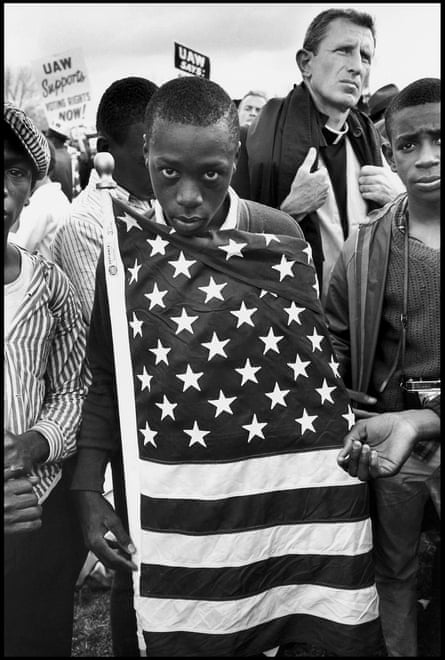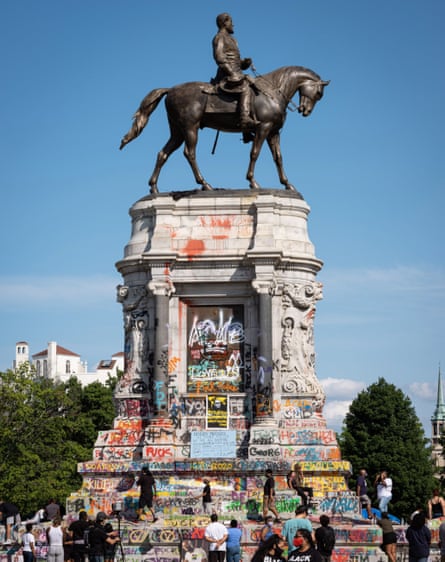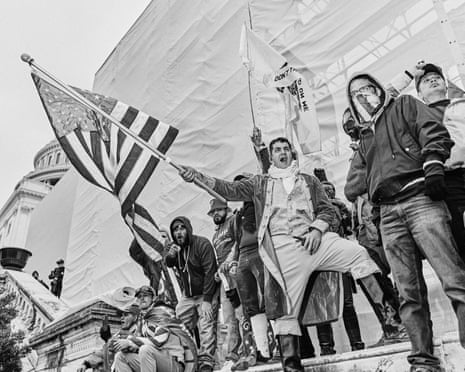On 30 May 2020, photographer Philip Montgomery captured a police charge during protests in Minneapolis against the killing of George Floyd. The cops look like giant metal insects, every human part of them hidden. You can’t see faces through the glinting visors, or flesh under their robotic armour as they approach with guns blazing through a pale mist of teargas smoke.
Blown up to the size of a painting, Montgomery’s spooky monochrome news photo looks like a premonition of the future in the Saatchi Gallery’s engrossing, unsettling exhibition America in Crisis. These sci-fi American stormtroopers mirror the warnings, a year on from the attack on the Capitol by Trump supporters, that the world’s most powerful democracy is heading for a second civil war. Yet America in Crisis is not only about the future. It’s about how the present may be understood by the past.
For this show juxtaposes photographs of the US’s current troubles with images of a divided country more than half a century ago. It takes its title from a project organised by the Magnum photographers’ agency in 1969. America in Crisis involved such renowned snappers as Bruce Davidson and Elliott Erwitt in an exhibition and book reporting the protests, assassinations and inequalities of the 1960s – a decade that seems in glowing retrospect almost incomparably more hopeful and joyous than today’s bitter times.

Yet the 60s don’t look so optimistic in Erwitt’s devastating photograph of Jackie Kennedy at her husband’s funeral in 1963. Today the most famous images of her black-clad mourning are Andy Warhol’s silkscreen pantings but where they are ashen icons, Erwitt takes us closer, through her veil, to see every twitch of her breaking face. Where she takes the tragedy of a nation on herself, Paul Fusco’s colour pictures of the train that carried Bobby Kennedy’s coffin from New York to Washington in 1968, met by grieving crowds along the way, portray a great community of pain. Black and white Americans squeeze together along a platform to salute the passing train, from which Fusco was watching with his camera.
In 2020 it was not the slaying of a famous politician that got people on the streets but the murder of a citizen, Floyd, during his arrest by Minneapolis police that united one half of America in tears of rage. One of the most convincing continuities in this exhibition is between images of the 60s civil rights movement and Black Lives Matter. Davidson’s photographs of the Selma freedom march in 1965 pick individuals out of the crowd whose faces make you wonder where they are now, what their later lives were like: a young Black marcher gazes at us over the American flag he’s carrying, asking a question America still hasn’t answered. Kris Graves’s picture of Robert E Lee’s equestrian statue in Richmond, Virginia in 2020, its colossal plinth completely covered with graffiti, points right past the 1960s to the never-healed wounds of slavery. The most startling images here from the original America in Crisis collection are portraits of Black sharecroppers in South Carolina in 1966. They seem still to be living in the Great Depression.

Perhaps America is timeless in its wrongs, its founding sin, the hypocrisy of a nation based on the declaration that all people “are created equal” when southern states based their way of life on slavery, so endemic in its history that it cannot go on like this. Yet as you explore America in Crisis, the parallels between past and present fade. Things are clearly getting worse.
There was hope and joy in 1969, after all. Protest, 60s style, seems innocent and childlike now. In Marc Riboud’s definitive image of the era, a young woman called Jane Rose Kasmir holds up a flower to the guns of National Guardsmen during an anti-war march in 1967. LOVE says the banner behind two protesters at the Democratic convention in 1968.
The keyword now is HATE. One photograph says it all: the silhouette of Donald Trump at a rally. There was no one like Trump in 1969. A picture of Richard Nixon is offered by comparison but any similarities are superficial: yes, Nixon showed how Republicans could benefit from culture wars by marshalling a “silent majority” of middle Americans horrified by the perceived excesses of the flower children, but when Watergate was exposed he went quietly. Trump refused to accept the result of a fair election, a lie his supporters still believe, and so took the US into completely uncharted territory.
You see this leap into chaos in photographs of the attack on the Capitol last January. Balasz Gardi photographed a man in 18th-century revolutionary garb waving the US flag with a gang of masked putschists on the Capitol steps. This character dressed for a far-right version of the musical Hamilton is claiming the heritage of the founding fathers for an act that spat on the democracy they created. At times of violent change, wrote Karl Marx, when people are “creating something previously non-existent, at just such epochs of … crisis they anxiously summon up the spirits of the past to their aid”. The Capitol rioters in their weird costumes from a half-forgotten American history opened a new age that nothing from the past can help us to understand. This absorbing exhibition leaves you stupefied by the crisis that’s beginning.
America in Crisis is at the Saatchi Gallery, London, from 21 January to 3 April.
